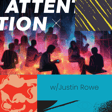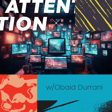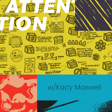Become a Creator today!Start creating today - Share your story with the world!
Start for free
00:00:00
00:00:01

How to Destroy Distractions for Your Marketing Team w/Charlie Riley
In this episode, Dan Sanchez talks to Charlie Riley who is the VP of Growth at Havoc Shield.
They talk about:
- Four ways to create more white space to do deep work.
- Why most marketers are failing to execute the basics.
- How he is creating focus for his marketing at Havoc Shield.
They talk about:
- Four ways to create more white space to do deep work.
- Why most marketers are failing to execute the basics.
- How he is creating focus for his marketing at Havoc Shield.
Transcript
Importance of Focus in Marketing
00:00:03
Speaker
Welcome back to the Attention Podcast, where you learn how to gain and retain the attention of your buyers to grow an audience. I'm Dan Sanchez with Sweetfish, and today I talk to Charlie Riley, who is the VP of growth at Havoc Shield, about how to destroy distractions for your marketing team. So we all know the hardest part about marketing is staying focused.
00:00:25
Speaker
There's never enough time, there's never enough people, there's never enough to go around to accomplish everything marketing possibly could do.
Creating White Space for Deep Work
00:00:33
Speaker
So in this interview, we talk about four ways to create more white space to do deep work, why most marketers are failing to execute the basics, and how he's creating focus for his marketing at Havoc Shield. Let's get into it.
00:00:50
Speaker
Charlie, welcome to the show. Thanks for having me, Dan.
Challenges to Maintaining Focus
00:00:53
Speaker
Appreciate it. Charlie, why do you think focus has become the key ingredient to audience growth for beauty marketers? I think there's two parts to it. Marketers are being asked to do, there's the shiny object syndrome. I think everyone throws a new idea at you and, hey, should we try this channel? Or should we look at this new social media opportunity? So that's one of them. And I think the second part of it is everyone spends a lot of time in meetings. I think the last report I saw
00:01:20
Speaker
most professionals spend 21 hours or more in meetings. And so the actual time to do the deep work is limited. And I think that that's something that everyone should work towards to try to give yourself more time because there needs to be a focus on actually getting the work done. And I think when you can limit that, it gives you more time to actually to work on the right things, not too many
Adapting Communication Styles to Minimize Distractions
00:01:43
Speaker
things.
00:01:43
Speaker
So what are you doing to eliminate distractions that have a shield? Well, I'm a team of one. So from a distraction standpoint, it's a little different. So when you're a marketing team of one or a very small team, you're working with different resources. So I have to combine outside consultants, freelancers. So trying to be very direct in communication with them is important. I think from a distraction standpoint, being clear in communication, and this goes
00:02:13
Speaker
this is really for any size organization or marketing team, the clear you can be in your communication and in the format from a learning style standpoint of how the other person likes to learn or needs to learn is very important. So what I mean by that is
00:02:29
Speaker
When you're giving direction, when you're talking about a campaign, when you're thinking about an activity, everyone's going to take that information differently. So a long format, someone might want to read the whole description. So there's a long format version of that. There's the too long didn't read version of that for someone that's just short and wants it quick. And then it might be helpful to record a video of that, a loom.
00:02:51
Speaker
something very big for the visual learners for them to digest it that way. So I think that's one way that I've been able to help those that are working on campaigns and projects of ours to focus in by giving them the information that they need in the format that they need it.
00:03:07
Speaker
That's a good tip, especially the format that they needed it, right? Especially, I mean, I do, and I do think like using Bomb Bomb or Loom or some kind of other video recording software is probably one of my key secret powers to creating clarity,
Using Video Tools for Clearer Communication
00:03:21
Speaker
right? Because text can always be misinterpreted, even in just tone. Even team members I've sent Slack messages to, they're like, oh, I thought you wanted to done all the right away, because it sounded really important. I'm like,
00:03:33
Speaker
No, I just said, hey, I don't know what I wrote out, but they interpreted it that way. In a loom, you'd be like, oh yeah, you could just hear the tone of how urgent something is, right?
00:03:43
Speaker
So a lot more gets communicated via those short video messages, and I find that they're actually faster to record than writing out thoroughly, right? They are. It's loom spin when you say superpower. It's a great tool for sales too, because I work on the sales side. It's a great follow-up. It breaks the noise a little bit. Most people are used to text, and very much so what you talked about. There's no way to tell tone in a text communication, and so that's very easy to be misinterpreted from others.
00:04:12
Speaker
huge believer in everyone has a different learning style. The visual side of it, like you said, it's very easy to record your thoughts there. You can transcribe it, which is helpful. But I think you brought up a very good point too, being direct in the deliverables. I think from an asynchronous standpoint, we work very synchronously. We use Slack, we use e-mail, we have meetings just like any other company. But I think being very deliberate and direct in here's when it's important and here's when I need it by.
00:04:40
Speaker
I actually just, I kind of shared something on LinkedIn recently about the order of prioritization that you should think about how you handle things, not only in the workplace, but at home. And so for what might seem like an important need for me might be very different for the person I'm communicating with and vice versa. So I think being very clear about that, here's the deadline I need to buy. Are there any things, any barriers that would be there to help us get some growth there?
00:05:05
Speaker
If there isn't great, I think we can agree on that. If there are, then let's talk through those and we can maybe re prioritize some things because that's also a thing that I think from a focus standpoint is difficult because we're being asked to do 20 30 different things and there's only so many hours in the week and the day to compile those.
00:05:23
Speaker
there are going to be things that sometimes maybe have to fall down the priority
Streamlining Processes with Clear Communication
00:05:27
Speaker
list. And I think that having a very direct and open conversation about what's attainable, what's actionable, and what might need to move down, I think gets both parties on the same page. That's great. So what else do you do to eliminate some of the other things that you think are holding back marketers from staying focused? You said you have too many meetings. Are you just moving more meetings to asynchronous meetings to deal with that?
00:05:50
Speaker
Yeah, we've been trying that and I think most companies are trying to find the sweet spot. Some of the things that I've done, the defaults are 30 minutes, 60 minute meetings. I've tried to do 20, 25 minute meetings or 45 minute meetings because the psychology of people is just that you'll fill up the time that's allotted to that meeting. People will kind of talk, they'll just, they see that as I have to talk through this or we have to finish this entire,
00:06:19
Speaker
time that's blocked out. So I think one thing that you can be cognizant of is start booking meetings that are shorter. And it's pretty interesting to see that you get the same amount of stuff done if you're being very direct, if that communication is, you know, you don't have to be a robot.
00:06:34
Speaker
but i think you can be very direct and be in and work on what needs to get done and you don't have to sit there on a meeting if if you're done and it's completed you're giving people time back of their day another thing that i think is helpful you can avoid meetings i think that that's something that there's an important level to that from a standpoint of. Being able to see tone be able to read people's faces if that's in person or via you know what we had to kind of.
00:07:00
Speaker
revert to. So that's not a bad thing. I don't think meetings are necessarily bad. Running effective meetings are important there, though. So being upfront about what the expectations are, if you're sharing an agenda, if you're sharing the right documents, I think that's one thing that you also want to help from a standpoint of don't make people go search for things.
00:07:19
Speaker
especially in text or tone, hey, where are we with this project? Responding with the link to the project management tool of where it's at, responding with the link to the files that the person's asking for. Don't make someone go search for something. And that goes towards the same kind of concept a marketer is looking for too.
00:07:37
Speaker
You never want to send someone to a homepage and hope that they find what you're looking for. That's why we build landing pages. That's why we track things. That's why you make it as simple and concise for the audience as possible. It goes to the same for being an internal communication or internal audience as well. Don't make someone go find something.
Avoiding Distractions from New Trends
00:07:56
Speaker
Be as direct as possible. Simplify the messaging. Sometimes marketers get very cute and we try to over-complicate things.
00:08:03
Speaker
I think the research has shown you get down to a fifth grade level. I know the tool Lavender talks about that all the time, that when you're in email marketing, if you're speaking at a fifth grade level, you're going to get a much better response. I think some of the takeaways that I've seen that have worked are trying to shorten up those meetings, so see if that
00:08:21
Speaker
that makes a difference. And most people don't really even notice that they're appreciative of that. Don't make people search. So give them what they want. Don't make them have to go back and forth and ask, well, where is that? Can you send me the link? Just do it. And I think the other part of that is, you know, being direct and that level of communication and directness of what you're looking for, especially in an asynchronous model is really helpful. Huge, dude, you just dropped some nuggets that I'm even thinking about. And some of these things I've heard before, but sometimes I'm like, yeah, but how well am I doing them?
00:08:49
Speaker
and I'm looking back over this and thinking like, I could be doing these better, especially the shorter meeting one. One thing I have done, one area where I've actually gotten this right that you probably noticed because in our pre-interview, I only give it 15 minutes.
00:09:01
Speaker
But to find an angle for an episode, you could easily fill an hour talking about topics and vetting them and going through them. But because I only set it to 15 minutes, it was a fast meeting, right, before we had this interview. And that's probably the short meeting where I'm trying to get a lot done, running through a list of POV discovery questions, setting expectations for the interview, and then scheduling time for the interview. I'm trying to accomplish in a very short window and have it done done before the time even ends so that I can jump onto the next meeting most of the time.
00:09:29
Speaker
But I've noticed with the amount of interviews I'm doing right now, it's massive, being able to get a lot done in a short period of time.
00:09:36
Speaker
So we've talked about what you're doing to eliminate the impact of meetings.
Balancing Innovation with Proven Strategies
00:09:41
Speaker
You also, Matt, talked about shiny object syndrome, which I think is getting a lot of us in marketing right now. It's not only getting us, but it's getting our bosses and our bosses' boss. And sometimes all the way up to the CEO has found some new LinkedIn post that talks about this new LinkedIn or some new marketing initiative with Web 3.0. Why aren't we doing Web 3.0? And you're like, ugh.
00:10:04
Speaker
In marketing, do I have to figure that out right now? So what are you doing to just overcome the barrage of information yourself and then requests coming externally?
00:10:14
Speaker
Yeah, that's a great topic. I'm sure every marketer, I was smiling because I'm sure every marketer has experienced that. Nieces' cousin saw this TikTok and wants, why aren't we doing that? Or it's email's dead, it doesn't work, let's try the new thing. And I'm not saying we do that here, but I think you can get caught up in trying to do too much. And I think that if it's B2B or B2C,
00:10:40
Speaker
There's always something new and that's exciting. Marketing is supposed to be, you're supposed to try new things. It's an exciting industry. However, when you focus on the basics, there are still things that work. And boring can work sometimes, especially. It doesn't mean your creative has to be boring.
00:10:59
Speaker
But the blocking and tackling of proven channels and proven executions, it doesn't mean you shouldn't experiment. And I like to when I look at budgets, I like to put a percentage of a budget towards experimentation. 15, 20 percent depends on what the budget is. But here are the core channels we're going to use. Here's where we're going to spend our money.
00:11:19
Speaker
and then we're going to put a pod of a small percentage to experiment, and you're always trying to define something new or you're trying to find a champion campaign or creative to beat that, and then you iterate on that. But there are channels that work. Email is still one of the best ROI channels there is. People think it's not sexy or it's not cool to use, but if you can personalize and you can segment email lists and you have a really clean email list,
00:11:44
Speaker
And you can write copy that's succinct and short and to the point and it helps people. It makes them think and then act. It's still a great channel. You know, people don't think about that sometimes of, well, that's not the new thing. That's not that's not something that, you know, someone's already done that.
00:12:01
Speaker
There's a good chance you haven't done it a hundred percent well there's no look the explosion of marketing ops and sales ops roles that are out there. There's a reason that that's important and me personally i think it took a long time for me to understand sometimes all the detail that goes into that i like to use the iceberg model or analogy a lot of times in marketing or just in life of.
00:12:23
Speaker
You see this, but everything underneath that's really, really important. And I think that that goes into setting up all the blocking and tackling and all the channels that from a growth standpoint, they might not be sexy. But if you've got really good attribution, if you've got a really clean database, if you've got first party data that you're not paying for or renting from somewhere else, that's what gets you results. And that's what helps to drive growth. That's what helps to drive new revenue streams. That's what helps to drive retention.
00:12:53
Speaker
So yes, there should be a percentage that goes to the shiny objects, but it shouldn't be 50 percent of your budget. It shouldn't be the majority of your budget because you're just going to go to the next thing and the next thing and the next thing. And you're really not going to have a core foundation of what works and give it the time it needs to work. That's right. Sometimes I wonder if, I don't know, a lot of people are like, oh, we don't have the right strategy. We don't have a right strategy. Sometimes I'm like, well,
00:13:21
Speaker
You're really just not executing very well.
Effective Audience Growth through Execution and Niches
00:13:23
Speaker
The strategy is fine. It's okay. It's maybe not the best, but if we could just execute well, then everything would probably be okay right now. Could the strategy be better? Always. The strategy could always use improvement. There's always another perspective that might be able to help, blah, blah, blah. But I'm like, if we could just get to actually executing things well, things would go smoother.
00:13:43
Speaker
So that being said, what are you guys executing right now in order to grow your audience? Since you're a team of one, but you have some vendors, agencies, freelancers that are helping you, that's kind of like, it's kind of your team, what are you guys focused on?
00:13:59
Speaker
Yeah, so the two topics kind of go together. The shiny object, it goes along with the focus and finding the right amount of time. Because again, time is the one finite object we all have. And so how do you find the right time to work on the right things? And I think that what we're doing is we're trying to figure out, and we've done some pivoting. We've moved to where the right audience sits.
00:14:23
Speaker
And I think that's important to, like you said, strategies can always be better. Like, you know, you never want to get to 100% because you're just that perfection prevents progress. And so you want to get to a point where you feel strong about that strategy and that execution you start doing, you got to move to action, but you can wait forever. And so what we've really focused in on is an audience
00:14:46
Speaker
that fits really well with our product. Our product is a cybersecurity, we're a cybersecurity startup. We work very well, I think, with companies that are 10 to 200, 250 employees. We also fit very well with financial institutions and fintech. And then we've also been able to find a product market fit with ancillary products within the insurance space.
00:15:07
Speaker
So narrowing in that focus has been really helpful, I think, for us to not try to boil the ocean because it's expensive to do that. It's extremely time consuming. And so if you can narrow in on a couple channels or audiences that you can get
00:15:22
Speaker
a really good return on from growth standpoint, from either acquisition right away, it depends on how long that sales cycle is, but either really good feedback, we've been getting great feedback from the insurance space because we've pivoted to a really good product market fit there. Starting with some of the audience that we know is in that sweet spot, we've been able to grow by getting good insight from them,
00:15:48
Speaker
getting good value props and then expanding out with those messages to some proven channels. LinkedIn, from a B2B standpoint, it's a great growth channel. Again, emails, it's still a great ROI if you can do it correctly and you have confidence in the database. We've been able to execute on some of those channels that make sense.
Targeting Specific Audiences for Maximum Growth
00:16:11
Speaker
Then we're looking at other ways because the insurance base,
00:16:15
Speaker
is still sort of an old school industry. And so there's still some channels and activities that you probably have to do that might not be the same that you'd focus in on as a SaaS startup. I mean, there's more traditional channels that we have to look at. So that's where we're spending maybe that small percentage, but we're able to do the digital things. We're able to drive people to landing pages that are very specific to them. Again, what I talked about, not having them search for things, and we're seeing good results from that.
Benefits of Focusing on Niche Markets
00:16:44
Speaker
Man, that's fantastic. And I expect you to say other things, but what you said was so much better. I expected to go into like tactical execution of this or that, but to start with just creating focus by segmenting the audience. I'm like, there's honestly not a better way you can create focus than just being really, really granular about who you're targeting.
00:17:04
Speaker
and having essentially a really small niche. And you could always level up once you've like saturated that niche, but most people don't like saturate a niche, right? Because they're trying to do too many. You could always go up from there, but to just pick up FinTech and insurance, I'm like, oh yeah, that's super nichey with cybersecurity. So it's like, it's a double niche. And then the only, essentially your two channels is LinkedIn and email. And then you give a little bit of, you give some wiggle room to try out new stuff on the side. Is that about right?
00:17:34
Speaker
Yeah, that's right, because like I said, when I started, we were trying to talk to all SaaS startups. Maybe they were VC funded. We had more than that as parameters. But that's a big, big network. And you're also trying to convince someone. The interesting thing about our industry, to some degree, is you're sometimes, more than likely, you're replacing something that they do not have, which is also an interesting conversation to have with someone. They're not currently paying for a resource.
00:18:03
Speaker
They maybe don't understand it or they don't think that they need it. There's a different sales tactic and growth execution there because you're replacing nothing sometimes. Originally, we were talking to a very wide audience. We narrowed that in because unless you're a large organization with huge budgets, we just saw the Super Bowl last night, those are companies that have big, big budgets to spend.
00:18:27
Speaker
more than likely companies are our size or maybe a little bit bigger, but you have to get really specific. And so we could have, you know, we started to narrow into all financial services and we are a fit there, but we've narrowed in even further because we've seen a really laser focused fit
Refining Messaging and Understanding Decision-Makers
00:18:44
Speaker
there. And so executing on a couple channels to start based on our bandwidth, what we see and as an opportunity there, we've been able to be really successful with that. Just like you said, then we'll branch out with that. There's there's certain
00:18:57
Speaker
personas within the insurance industry that we're talking to now, we will probably branch out with that. There's carriers that we can now expand upon after we've shown results there. I think going really narrow and getting really good at figuring out the messaging, figuring out from it, you asked about tactical, it's figuring out the messaging, it's figuring out who the decision-maker is, it's figuring out who else needs to be a part of that conversation, it's figuring out where they spend their time,
00:19:26
Speaker
And then you can grow that funnel out to talk to more people that look, talks, they buy in the same way. But like you said, the more narrow you can get and get really good at that, it's kind of boring. I mean, to be honest, it's not the shiny object syndrome. It's boring, blocking, and tackling. But that's what works.
00:19:46
Speaker
And then you add on the layer of the shiny objects, and then you add on some of the nuance stuff. But it's getting really good at the blocking and tackling with one audience, with really knowing that, the database, the audience there, and then expanding out beyond that.
00:20:03
Speaker
Charlie, this has been fantastic. And honestly, like, I will not be surprised when I see you guys doubling and tripling to the future. And I'm sure like you're saying you're having success. I'm like, yeah, I'm like, it's just not shocking because I'm like, you're just doing the things that everybody needs to do and just staying focused on what needs to get done. Kind of like, you know, you hear about professional basketball players and how they're just doing the basic drills over and over and over and they just never get
00:20:28
Speaker
board of doing the basics again and again to become great. And that's what I'm hearing right now is like you're just doing diligence and focusing on what it takes to actually do great marketing, which is not getting distracted. And even throughout a reason that I hadn't considered before is marketers just getting bored with doing the same old, same old state focused on the same topics. That's probably another reason that hasn't occurred to me of why marketers are so distracted is because their own boredom.
00:20:53
Speaker
So this has been good. Not to cut you off, Dan, but I think that that's important because I think marketers feel like they have to bring the next idea. They have to. That's the expectation. And maybe that's, you know, I'm a big believer of internal communication.
00:21:08
Speaker
The more that you can help others in the organization, the sales leader, the CEO, the CFO, who's helping to figure out budgets with you, it's helping them understand we're getting really good results from these things. Why change things up sometimes? And that's, again, not to say you can't bring new ideas. You should be bringing new ideas. You should be trying new things. You should always be iterating on creative. You should be trying new messaging. But get really good at some of the boring things sometimes. You brought up a really good analogy. I used to coach basketball.
00:21:37
Speaker
I used to play, the ones that you do those boring Mike and drills, you're doing the same thing over and over again, but I think it's that Malcolm Gladwell analogy of the 10,000 hours to be an expert. You're doing the same thing over and over again, then it's like riding a bike. It's very executable. I think you bring up a good point thereof.
00:21:59
Speaker
You should be bringing ideas, but there's no shame in being able to do the right steps, especially in B2B. That's what delivers growth. You should be thinking, you should be creative, but I think that sometimes boring isn't boring. It's the basics, people. Just got to get the basics right. Charlie, thank you so much for joining me on the show. It's been a delight to have you. Where can people go to learn more from you and learn more about Havoc Shield online?
00:22:24
Speaker
Yeah, ironically, I'm going to send them to our our homepage. But if they visit Havocshield.com, they can find more. But yeah, I would normally probably send them to a landing page. But you know, the nice part about our product is it's for any size company because really anyone needs really any size, any company needs cybersecurity right now. So they visit Havocshield.com. They can learn more. Awesome. And where can people learn more about you?
00:22:47
Speaker
I'm active on LinkedIn, on Twitter, you can find me at Charlie Riley, looking me up on LinkedIn, but happy to connect, happy to talk to any other marketers, and thank you for having me. This is always a pleasure and this has been great. Thanks, Dan. Great.
Reflecting on Niche Targeting and Focus
00:23:01
Speaker
Thanks for joining me today.
00:23:03
Speaker
Now let's talk about what caught my attention. Charlie Riley. I was not expecting the interview to go how it did. It ended up being so basic, so simple. It's something that just stares you in the face, but it's something that I feel like we all need a strong reminder of. That the blocking of tackling of marketing is really simple if we can just stay focused and get it right. And the way he led with what he's doing, I was like, that's it. That's the perfect thing. That is literally the biggest reason why most marketers get
00:23:33
Speaker
sidetracked is from bad positioning and honestly not going niche enough with their product or with their service. It's one of the reasons why Sweetfish is so able to grow and I think we might even be able to level down a bit. Probably worth discussing with the team.
00:23:48
Speaker
The fact that Sweetfish is focused on B2B podcasting, so not just our full service marketing agency, not just focused on anybody and everybody who wants to give us some marketing work. No, we only execute podcasts and we only do it for B2B companies, creates so much focus and clarity for Sweetfish that I'm like, yes, this is the reason why they get distracted for most people. And I think even internally, I think we could even go probably more narrow than
00:24:15
Speaker
B2B and focus just on b2b tech or just b2b sass you know just a smaller narrow part of tech even though that's our sweet spot we probably won't change just focus on b2b's we have a lot of customers across the b2b spectrum but still it creates so much clarity to say you know what we're not focused on building a product or doing marketing for any of these other segments or maybe. We only focus the marketing on this one segment and will allow other people to come in if they come to us that's fine.
00:24:41
Speaker
but it's this one segment that we're going to really focus in on because they're the most profitable and tend to be the ones that are the best fit, the ones we can serve the best. When you do that, you create clarity with your marketing. It eliminates a lot of distraction because now there's a lot of things you don't have to worry about because your customer isn't everywhere. They're probably only in a few places. The other thing he did is the two-channel rule, something I've talked about earlier on this podcast, that creates growth is the simplicity of only focusing on two freaking channels, right?
00:25:11
Speaker
And for him, it's LinkedIn and email. And you might scoff at email, but for a lot of people, it's still really working. And my game plan is to have a short form channel and a long form channel. To me, email can certainly count as the long form channel. It's an owned media audience, and it's more deeply owned than LinkedIn. But LinkedIn is a great place for discoverability, a great place to engage with people that aren't your potential buyers yet in order to get them onto the email list. If you're doing email right, that can certainly work.
00:25:41
Speaker
So that's the big takeaway I have for me. It's more of a reminder myself, stay focused. Two-channel rule, solid positioning. It makes me even wonder if the positioning for this podcast is niche enough. Because you need to think about not just positioning for your company, but positioning for your audience growth, even for this very podcast. Who am I targeting? Who am I focused on? That's something I need to explore more. In order to grow this channel faster, I need to focus on less people and focus more
00:26:10
Speaker
on the right people. Who are the right people? That's my takeaway for this podcast.
















